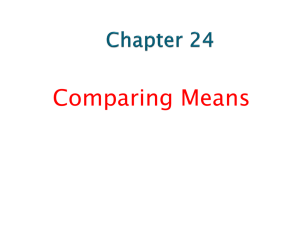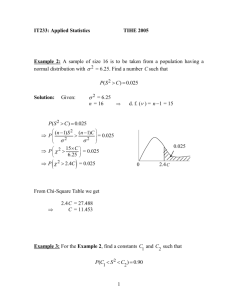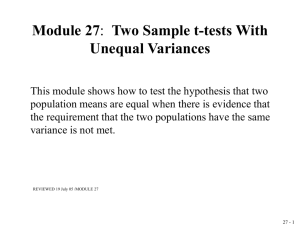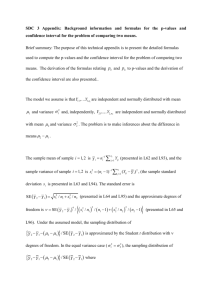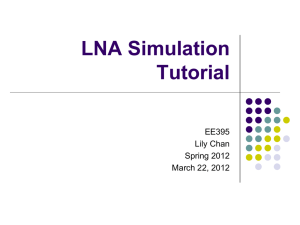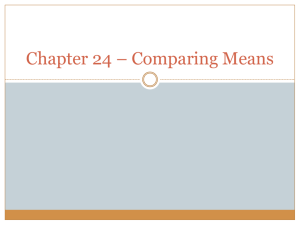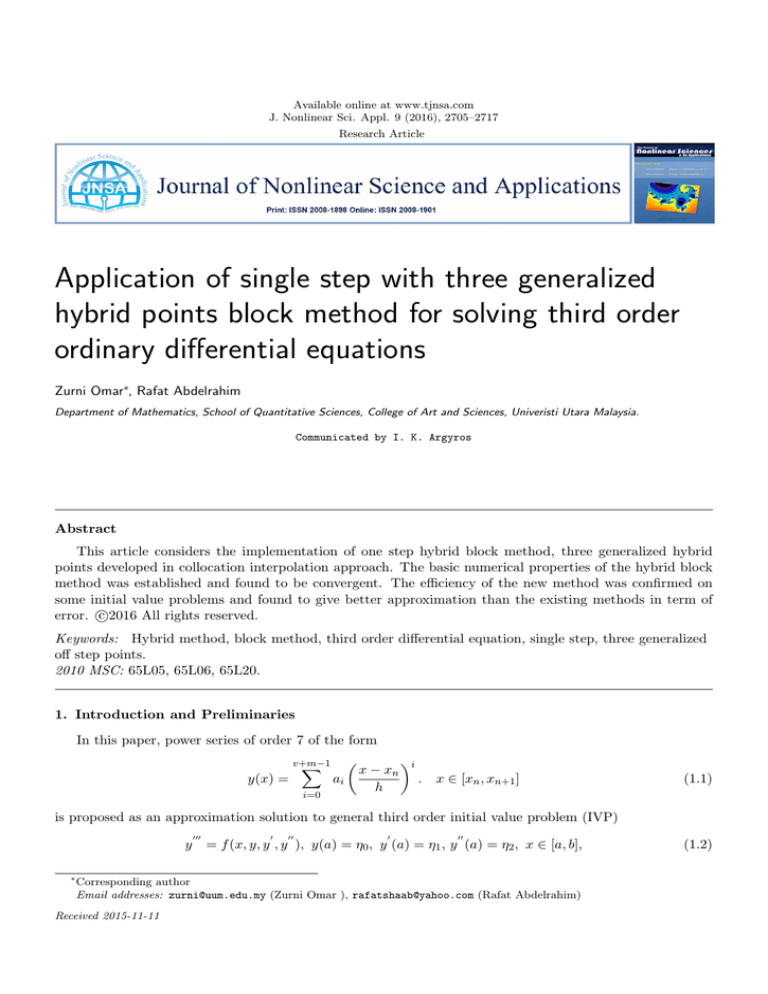
Available online at www.tjnsa.com
J. Nonlinear Sci. Appl. 9 (2016), 2705–2717
Research Article
Application of single step with three generalized
hybrid points block method for solving third order
ordinary differential equations
Zurni Omar∗, Rafat Abdelrahim
Department of Mathematics, School of Quantitative Sciences, College of Art and Sciences, Univeristi Utara Malaysia.
Communicated by I. K. Argyros
Abstract
This article considers the implementation of one step hybrid block method, three generalized hybrid
points developed in collocation interpolation approach. The basic numerical properties of the hybrid block
method was established and found to be convergent. The efficiency of the new method was confirmed on
some initial value problems and found to give better approximation than the existing methods in term of
c
error. 2016
All rights reserved.
Keywords: Hybrid method, block method, third order differential equation, single step, three generalized
off step points.
2010 MSC: 65L05, 65L06, 65L20.
1. Introduction and Preliminaries
In this paper, power series of order 7 of the form
y(x) =
v+m−1
X
i=0
ai
x − xn
h
i
.
x ∈ [xn , xn+1 ]
(1.1)
is proposed as an approximation solution to general third order initial value problem (IVP)
y
∗
000
0
00
0
00
= f (x, y, y , y ), y(a) = η0 , y (a) = η1 , y (a) = η2 , x ∈ [a, b],
Corresponding author
Email addresses: zurni@uum.edu.my (Zurni Omar ), rafatshaab@yahoo.com (Rafat Abdelrahim)
Received 2015-11-11
(1.2)
Z. Omar, R. Abdelrahim, J. Nonlinear Sci. Appl. 9 (2016), 2705–2717
2706
where n = 0, 1, 2, ..., N − 1, v = 3 denotes of the number of interpolation points, m = 5 represents the
number of collocation points, h = xn − xn−1 is constant step size of partition in the interval [a, b] which is
given by a = x0 < x1 < ... < xN −1 < xN = b.
Conventionally, Equation (1.2). is reduced to systems of first order (IVP) and then, suitable methods
for first order equations are adopted to solve them.
Reduction approach has been identified to have some drawbacks which include computer burden and alots
of human efforts [1, 7, 10] and [14]. Because of this, many researchers have attempted to solve Equation(1)
directly . Worthy of note are those of [4, 5, 6, 12] and [13].
Direct method was implemented in different ways such as predictor-corrector method, block linear multistep method and hybrid block method.
Hybrid block method was introduced to combine the advantages of block method and overcoming the
zero stability barrier in linear multistep method [2, 3]. This barrier implies that the highest order of zero
stability for linear multistep method of step length k is k+2 when k is even and k+1 when k is odd [9].
In this work, efforts are made to develop one step hybrid block method with three generalized hybrid points
for solving (1.1) directly.
2. Derivation of the Method
interpolating Equation (1.1) at points xn , xn+s1 , xn+s2 and collocating its third derivative at all points
i.e xn , xn+s1 , xn+s2 and xn+s2 gives system of equations below
1 0 0 0
0
0
0
0
a0
yn
5
6
7
1 s1 s2 s3 s4
s1
s1
s1 a y
1
1
1
1 s s2 s3 s4
1 n+s1
5
6
s2
s2
s72
2
a2 yn+s2
2
2
2
0 0 0 6
0
0
0
0
a3 fn
h3
2
3
4
210s1
(2.1)
1
0 0 0 63 24s31 60s31 120s
= fn+s .
h
h
h 2
h3 3
h3 4 a4
1
0 0 0 6 24s2 60s2 120s2 120s2 a5 fn+s
2
h3
h3
h32
h3 3
h3
fn+s
120s43 a6
3
3
0 0 0 63 24s33 60s33 120s
h
h
h
h3
h3
a
f
6
24
60
120
210
7
n+1
0 0 0
h3
h3
h3
h3
h3
Using Gaussian elimination method in (2.1) to find the values of ai s, i = 0(1)8 and ai s are then
substituted back into equation (1.1). This gives a continuous linear multistep method of the form:
y(x) = α0 yn +
2
X
αsi yn+si +
1
X
i=1
βi fn+i +
i=0
3
X
βsi fn+si .
(2.2)
i=1
The first and second derivatives of equation (2.2) are given by
0
y (x) =
2
1
3
i=0
i=0
i=1
X ∂
X ∂
X ∂
∂
α 0 yn +
αi (x)yn+i +
βi (x)fn+i +
βs (x)fn+si ,
∂x
∂x
∂x
∂x i
2
1
3
i=1
i=0
i=1
X ∂2
X ∂2
X ∂2
∂2
y (x) =
α
y
+
α
(x)y
+
β
(x)f
+
βs (x)fn+si ,
0
n
s
n+s
s
n+i
i
i
i
∂x2
∂x2
∂x2
∂x2 i
00
where
(xn − x + hs2 )(xn − x + hs1 )
,
(h2 s1 s2 )
((x − xn )(x − xn − hs2 ))
,
=
(h2 s1 (s1 − s2 ))
α0 =
αs1
(2.3)
(2.4)
Z. Omar, R. Abdelrahim, J. Nonlinear Sci. Appl. 9 (2016), 2705–2717
(x − xn )(xn − x + hs1 )
,
(h2 s2 (s1 − s2 ))
(x − xn )(xn − x + hs2 )(xn − x + hs1 )
β0 = −
(7hx3 + 3h3 s31 x − 24x2 x2n + 7hs3 x3
(840h4 s1 s2 s3 )
+ 16x3 xn − 4x4 − 4x4n − 7h4 s31 + 3h4 s41 − 7h4 s32 + 3h4 s42 + 3hs1 x3 + 3hs2 x3 + 16xx3n
αs2 =
− 3hs1 x3n − 3hs2 x3n − 7hs3 x3n + 21hxx2n − 21hx2 xn + 14h4 s1 s22 + 14h4 s21 s2 − 4h4 s1 s32
− 4h4 s31 s2 + 21h4 s21 s3 − 7h4 s31 s3 + 21h4 s22 s3 − 7h4 s32 s3 −, 7h2 s1 x2 − 7h3 s21 x
− 7hx3n − 7h2 s2 x2 − 7h3 s22 x + 3h3 s32 x − 14h2 s3 x2 − 7h2 s1 x2n + 7h3 s21 xn − 3h3 s31 xn
+ 7h3 s22 xn − 3h3 s32 xn − 14h2 s3 x2n , −4h4 s21 s22 + 3h2 s21 x2 − 14h3 s1 s2 xn − 21h3 s1 s3 xn
+ 3h2 s22 x2 + 3h2 s21 x2n + 3h2 s22 x2n − 84h4 s1 s2 s3 + 14h3 s1 s2 x + 21h3 s1 s3 x + 9hs1 xx2n
+ 21h3 s2 s3 x − 21h3 s2 s3 xn + 14h2 s1 xxn + 9hs2 xx2n − 9hs2 x2 xn + 14h2 s2 xxn
+ 21hs3 xx2n + 28h2 s3 xxn + 14h4 s1 s22 s3 + 14h4 s21 s2 s3 − 4h2 s1 s2 x2 − 4h3 s1 s22 x
− 4h3 s21 s2 x , −7h2 s1 s3 x2 − 7h3 s21 s3 x − 7h2 s2 s3 x2 − 4h2 s1 s2 x2n + 4h3 s1 s22 xn
+ 4h3 s21 s2 xn − 7h2 s1 s3 x2n + 7h3 s21 s3 xn − 7h2 s2 s3 x2n + 7h3 s22 s3 xn + 14h2 s2 s3 xxn
− 6h2 s22 xxn + 14h3 s1 s2 s3 x − 14h3 s1 s2 s3 xn + 8h2 s1 s2 xxn + 14h2 s1 s3 xxn − 6h2 s21 xxn
− 9hs1 x2 xn − 21hs3 x2 xn − 7h3 s22 s3 x − 7h2 s2 x2n ) ,
β s1 =
(x − xn )(xn − x + hs2 )(xn − x + hs1 )
(24x2 x2n − 14h2 s2 xxn + 4h3 s31 x + 4h4 s41
(840h4 s1 (s1 − 1)(s1 − s3 )(s1 − s2 ))
+ 6h2 s22 xxn − 3h3 s1 s22 x − 16x3 xn + 4x4n + 7h4 s32 − 3h4 s42 + 4hs1 x3 − 14h3 s1 s3 xn
− 4hs1 x3n + 3hs2 x3n + 7hs3 x3n − 21hxx2n + 21hx2 xn + 7h4 s1 s22 + 7h4 s21 s2 + 3h3 s1 s22 xn
− 3h4 s31 s2 + 14h4 s21 s3 − 7h4 s31 s3 − 21h4 s22 s3 + 7h4 s32 s3 − 7h2 s1 x2 − 7h3 s21 x − 16xx3n
+ 7h2 s2 x2 + 7h3 s22 x − 3h3 s32 x + 14h2 s3 x2 − 7h2 s1 x2n + 7h3 s21 xn − 4h3 s31 xn + 7h2 s2 x2n
− 7h3 s22 xn + 3h3 s32 xn + 14h2 s3 x2n − 3h4 s21 s22 + 4h2 s21 x2 − 3h2 s22 x2 + 4h2 s21 x2n + 7hx3n
− 21h4 s1 s2 s3 + 7h3 s1 s2 x + 14h3 s1 s3 x − 21h3 s2 s3 x − 7h3 s1 s2 xn − 3hs2 x3 − 3h2 s22 x2n
+ 21h3 s2 s3 xn + 12hs1 xx2n − 12hs1 x2 xn + 14h2 s1 xxn − 9hs2 xx2n + 9hs2 x2 xn − 7hs3 x3
− 21hs3 xx2n + 21hs3 x2 xn − 28h2 s3 xxn + 7h4 s1 s22 s3 + 7h4 s21 s2 s3 − 3h2 s1 s2 x2 − 7hx3
− 3h3 s21 s2 x − 7h2 s1 s3 x2 − 7h3 s21 s3 x + 7h2 s2 s3 x2 + 7h3 s22 s3 x − 3h2 s1 s2 x2n − 3h4 s1 s32
+ 3h3 s21 s2 xn − 7h2 s1 s3 x2n + 7h3 s21 s3 xn + 7h2 s2 s3 x2n − 7h3 s22 s3 xn − 8h2 s21 xxn − 7h4 s31
+ 7h3 s1 s2 s3 x − 7h3 s1 s2 s3 xn + 6h2 s1 s2 xxn + 14h2 s1 s3 xxn − 14h2 s2 s3 xxn + 4x4 ) ,
β s2 =
(x − xn )(xn − x + hs2 )(xn − x + hs1 )
(7hx3 − 24x2 x2n + 16xx3n + 3h3 s31 x − 4x4
(840h4 s2 (s2 − 1)(s2 − s3 )(s1 − s2 ))
+ 16x3 xn − 4x4n − 7h4 s31 + 3h4 s41 + 7h4 s32 − 4h4 s42 + 3hs1 x3 − 4hs2 x3 + 21h4 s1 s2 s3
− 3hs1 x3n + 4hs2 x3n − 7hs3 x3n + 21hxx2n − 21hx2 xn − 7h4 s1 s22 − 7h4 s21 s2 + 3h4 s1 s32
+ 3h4 s31 s2 + 21h4 s21 s3 − 7h4 s31 s3 − 14h4 s22 s3 + 7h4 s32 s3 − 7h2 s1 x2 − 7h3 s21 x − 7hx3n
+ 7h3 s22 x − 4h3 s32 x − 14h2 s3 x2 − 7h2 s1 x2n + 7h3 s21 xn − 3h3 s31 xn + 7h2 s2 x2n − 7h3 s22 xn
+ 4h3 s32 xn − 14h2 s3 x2n + 3h4 s21 s22 + 3h2 s21 x2 − 4h2 s22 x2 + 3h2 s21 x2n − 7h3 s22 s3 xn
+ 28h2 s3 xxn + 21h3 s1 s3 x − 14h3 s2 s3 x + 7h3 s1 s2 xn − 21h3 s1 s3 xn + 14h3 s2 s3 xn
+ 14h2 s1 xxn − 12hs2 xx2n + 12hs2 x2 xn − 14h2 s2 xxn + 21hs3 xx2n − 21hs3 x2 xn
2707
Z. Omar, R. Abdelrahim, J. Nonlinear Sci. Appl. 9 (2016), 2705–2717
2708
− 7h4 s21 s2 s3 + 3h2 s1 s2 x2 + 3h3 s1 s22 x + 3h3 s21 s2 x − 7h2 s1 s3 x2 − 7h3 s21 s3 x + 7hs3 x3
+ 3h2 s1 s2 x2n − 3h3 s1 s22 xn − 3h3 s21 s2 xn − 7h2 s1 s3 x2n + 7h3 s21 s3 xn + 7h2 s2 s3 x2n
+ 8h2 s22 xxn − 7h3 s1 s2 s3 x + 7h3 s1 s2 s3 xn − 6h2 s1 s2 xxn + 14h2 s1 s3 xxn − 14h2 s2 s3 xxn
− 6h2 s21 xxn + 7h3 s22 s3 x − 7h4 s1 s22 s3 − 9hs1 x2 xn + 7h2 s2 x2 + 9hs1 xx2n + 7h2 s2 s3 x2
− 4h2 s22 x2n − 7h3 s1 s2 x) ,
(x − xn )(xn − x + hs2 )(xn − x + hs1 )
(3h4 s41 − 4h4 s31 s2 − 7h4 s31 − 4h4 s21 s22
(840h4 s3 (s3 − 1)(s2 − s3 )(s1 − s3 ))
+ 14h4 s21 s2 − 4h4 s1 s32 + 14h4 s1 s22 + 3h4 s42 − 7h4 s32 + 3h3 s31 x − 3h3 s31 xn − 4h3 s21 s2 x
βs3 = −
+ 4h3 s21 s2 xn − 7h3 s21 x + 7h3 s21 xn − 4h3 s1 s22 x + 4h3 s1 s22 xn + 14h3 s1 s2 x − 14h3 s1 s2 xn
− 3h3 s32 xn − 7h3 s22 x + 7h3 s22 xn + 3h2 s21 x2 − 6h2 s21 xxn + 3h2 s21 x2n − 4h2 s1 s2 x2 − 4x4n
− 4h2 s1 s2 x2n − 7h2 s1 x2 + 14h2 s1 xxn − 7h2 s1 x2n + 3h2 s22 x2 − 6h2 s22 xxn + 3h2 s22 x2n
− 7h2 s2 x2 + 14h2 s2 xxn − 7h2 s2 x2n + 3hs1 x3 + 9hs1 xx2n − 3hs1 x3n + 3hs2 x3 + 16xx3n
− 9hs2 x2 xn + 9hs2 xx2n − 3hs2 x3n + 7hx3 − 21hx2 xn + 21hxx2n − 7hx3n − 4x4 + 16x3 xn
+ 3h3 s32 x − 24x2 x2n − 9hs1 x2 xn + 8h2 s1 s2 xxn ) ,
β1 =
(x − xn )(xn − x + hs2 )(xn − x + hs1 )
(3h4 s41 − 4h4 s31 s2 − 7s3 h4 s31 − 4h4 s21 s22
(840h4 (s3 − 1)(s2 − 1)(s1 − 1))
− 4x4 + 14s3 h4 s21 s2 − 4h4 s1 s32 + 14s3 h4 s1 s22 + 3h4 s42 − 7s3 h4 s32 + 3h3 s31 x + 16x3 xn
− 4h3 s21 s2 x + 4h3 s21 s2 xn − 7s3 h3 s21 x + 7s3 h3 s21 xn − 4h3 s1 s22 x + 4h3 s1 s22 xn + 3hs2 x3
+ 14s3 h3 s1 s2 x − 14s3 h3 s1 s2 xn + 3h3 s32 x − 3h3 s32 xn − 7s3 h3 s22 x + 7s3 h3 s22 xn − 4x4n
+ 3h2 s21 x2 − 6h2 s21 xxn + 3h2 s21 x2n − 4h2 s1 s2 x2 + 8h2 s1 s2 xxn − 4h2 s1 s2 x2n + 16xx3n
− 7s3 h2 s1 x2 + 14s3 h2 s1 xxn − 7s3 h2 s1 x2n + 3h2 s22 x2 − 6h2 s22 xxn − 3hs1 x3n − 3hs2 x3n
− 7s3 h2 s2 x2 + 14s3 h2 s2 xxn − 7s3 h2 s2 x2n + 3hs1 x3 − 9hs1 x2 xn + 9hs1 xx2n − 7s3 hx3n
− 9hs2 x2 xn + 9hs2 xx2n + 3h2 s22 x2n + 7s3 hx3 − 21s3 hx2 xn + 21s3 hxx2n − 24x2 x2n
− 3h3 s31 xn ) .
Equation (2.2) is evaluated at the non-interpolating point i.e xn+s3 , xn+1 and equations (2.3) and (2.4)
are evaluated at all points to produce the discrete schemes and its derivatives. The discrete scheme and its
derivatives at xn are combined in matrix to form a block
A[3]3 Ym[3]3
[3]
[3]3
= B1 3 R1
[3]
[3]3
+ B2 3 R 2
[3]
[3]3
0 1
+ B3 3 R3
[3]3
+ h3 D[3]3 R4
[3]3
+ h3 E [3]3 R5
,
where
A[3]3
=
[3]3
B1
(s2 −1)
(s1 (s1 −s2 ))
(s3 (s2 −s3 ))
(s1 (s1 −s2 ))
s2
(hs1 (s1 −s2 ))
2
− (h2 s2 −h
2s s
1 2
1
0 0 0
0 0 0
=
0 0 0
0 0 0
− (s2(s(s11−1)
−s2 ))
(s3 (s1 −s3 ))
− (s
2 (s1 −s2 ))
− (hs2 (ss11−s2 ))
2
− (h2 s2 −h
2s s )
2
((s1 −1)(s2 −1))
(s1 s2 )
((s1 −s3 )(s2 −s3 ))
(s1 s2 )
1 +s2 )
− (s
(hs1 s2 )
2
(h2 s1 s2 )
1 2
yn+s1
1 0
, Ym[3]3 = yn+s2
yn+s3
0 0
yn+1
0 0
yn−3
, R[3]3 yn−2
1 y
n−1
yn
, B [3]3
2
0
0
=
0
0
,
0
0
0
0
0 0
0 0
,
0 0
0 −1
(2.5)
Z. Omar, R. Abdelrahim, J. Nonlinear Sci. Appl. 9 (2016), 2705–2717
0
yn−3
0 0
0
yn−2
, B [3]3 = 0 0
=
3
y0
0 0
n−1
0
0 0
yn
00
yn−3
0 0
00
0 0 [3]3 yn−2
,
R
=
00
y
0 0 3
n−1
00
0 −1
yn
[3]3
E11
fn−3
[3]
fn−2
E21 3
, E [3]3 =
=
[3]3
fn−1
E31
[3]
fn
E41 3
E12 3
[3]
E21 3
[3]
E32 3
[3]
E42 3
[3]3
R2
[3]3
R4
[3]
[3]
E13 3
[3]
E23 3
[3]
E33 3
[3]
E43 3
[3]
E14 3
[3]
E24 3
[3]
E34 3
[3]
E44 3
2709
, D[3]3 =
[3]
, R6 3
0
0
0
0
0
0
0
0
0
0
0
0
fn+s1
fn+s2
=
fn+s3 .
fn+1
Non-zero elements in D[3]3 and E [3]3 are given by
[3]
(s2 − 1)(s1 − 1)
(10s1 s2 − 4s2 − 7s3 − 4s21 s22 − 4s1 + 14s1 s3 + 14s2 s3 − 4s31
(840s1 s2 s3 )
+ 10s1 s22 + 10s21 s2 − 4s1 s32 − 4s31 s2 + 14s21 s3 − 7s31 s3 + 14s22 s3 − 7s32 s3 − 4s21
D14 3 = −
+ 3s41 − 4s22 − 4s32 + 3s42 + 14s1 s22 s3 + 14s21 s2 s3 − 70s1 s2 s3 + 3) ,
[3]
(s1 − s3 )(s2 − s3 ) 4
(3s1 − 4s31 s2 − 4s31 s3 − 7s31 − 4s21 s22 + 10s21 s2 s3
(840s1 s2 )
+ 14s21 s2 − 4s21 s23 + 14s21 s3 − 4s1 s32 + 10s1 s22 s3 + 14s1 s22 + 10s1 s2 s23
D24 3 = −
− 70s1 s2 s3 − 4s1 s33 + 14s1 s23 + 3s42 − 4s32 s3 − 7s32 − 4s22 s23 + 14s22 s3
− 4s2 s33 + 14s2 s23 + 3s43 − 7s33 ) ,
[3]
D34 3 =
[3]
D44 3 =
−1
(14s1 s22 − 4s21 s22 + 14s21 s2 − 4s1 s32 − 4s31 s2 + 21s21 s3 − 7s31 s3 + 3s42
(840s3 h2 )
+ 21s22 s3 − 7s32 s3 − 7s31 + 3s41 − 7s32 + 14s1 s22 s3 + 14s21 s2 s3 − 84s1 s2 s3 ) ,
1
(14s21 s22 − 4s21 s32 − 4s31 s22 + 14s1 s32 + 14s31 s2 − 4s1 s42 − 4s41 s2
(420h3 s1 s2 s3 )
+ 21s31 s3 − 7s41 s3 + 21s32 s3 − 7s42 s3 − 7s41 + 3s51 − 7s42 + 3s52 − 84s1 s22 s3
− 84s21 s2 s3 + 14s1 s32 s3 + 14s31 s2 s3 + 14s21 s22 s3 ) ,
[3]
E11 3 =
(s2 − 1)
(4s2 − 3s1 + 7s3 − 3s21 s22 + 4s1 s2 + 7s1 s3 − 3s21
840s1 (s1 − s2 )(s1 − s3 )
− 14s2 s3 + 4s1 s22 + 4s21 s2 − 3s1 s32 − 3s31 s2 + 7s21 s3 − 7s31 s3 − 14s22 s3 + 4s41
+ 7s32 s3 − 3s31 + 4s22 + 4s32 − 3s42 + 7s1 s22 s3 + 7s21 s2 s3 − 14s1 s2 s3 − 3) ,
[3]
(s1 − 1)
(4s1 − 3s2 + 7s3 − 3s21 s22 + 4s1 s2 − 14s1 s3 − 3s22
840s2 (s1 − s2 )(s2 − s3 )
+ 7s2 s3 + 4s1 s22 + 4s21 s2 − 3s1 s32 − 3s31 s2 − 14s21 s3 + 7s31 s3 + 7s22 s3 − 3s32
E12 3 = −
− 7s32 s3 + 4s21 + 4s31 − 3s41 + 4s42 + 7s1 s22 s3 + 7s21 s2 s3 − 14s1 s2 s3 − 3) ,
[3]
(s2 − 1)(s1 − 1)
(3s41 − 4s31 s2 − 4s31 − 4s21 s22 + 10s21 s2
(840s3 (s1 − s3 )(s2 − s3 )(s3 − 1))
− 4s21 − 4s1 s32 + 10s1 s22 + 10s1 s2 − 4s1 + 3s42 − 4s32 − 4s22 − 4s2 + 3) ,
E13 3 = −
[3]
D14 3
[3]
D24 3
[3]
D34 3
[3]
D44 3
,
Z. Omar, R. Abdelrahim, J. Nonlinear Sci. Appl. 9 (2016), 2705–2717
1
(4s2 s2 − 3s2 − 7s3 − 3s1 + 4s1 s2 + 7s1 s3 + 7s2 s3 + 4s1 s22
(840s3 − 840) 1 2
+ 4s21 s2 + 4s1 s32 + 4s31 s2 + 7s21 s3 + 7s31 s3 + 7s22 s3 + 7s32 s3 − 3s21 − 3s31 − 3s41
[3]
E14 3 = −
− 3s22 − 3s32 − 3s42 − 14s1 s22 s3 − 14s21 s2 s3 − 14s1 s2 s3 + 4) ,
[3]
E21 3 =
s3 (s2 − s3 )
(4s4 − 3s31 s2 − 3s31 s3 − 7s31 − 3s21 s22 + 4s21 s2 s3 − 3s43
(840s1 (s1 − s2 )(s1 − 1)) 1
+ 7s21 s2 − 3s21 s23 + 7s21 s3 − 3s1 s32 + 4s1 s22 s3 + 7s1 s22 + 4s1 s2 s23 − 14s1 s2 s3 + 7s33
− 3s1 s33 + 7s1 s23 − 3s42 + 4s32 s3 + 7s32 + 4s22 s23 − 14s22 s3 + 4s2 s33 − 14s2 s23 ) ,
[3]
E22 3 =
−s3 (s1 − s3 )
(−3s41 − 3s31 s2 + 4s31 s3 + 7s31 − 3s21 s22 + 4s21 s2 s3 + 4s42
840s2 (s1 − s2 )(s2 − 1)
+ 7s21 s2 + 4s21 s23 − 14s21 s3 − 3s1 s32 + 4s1 s22 s3 + 7s1 s22 + 4s1 s2 s23 − 14s1 s2 s3
− 3s43 + 4s1 s33 − 14s1 s23 − 3s32 s3 − 7s32 − 3s22 s23 + 7s22 s3 − 3s2 s33 + 7s2 s23 + 7s33 ) ,
[3]
E23 3 =
[3]
E24 3
1
(−3s41 + 4s31 s2 − 3s31 s3 + 7s31 + 4s21 s22 + 4s21 s2 s3 − 14s21 s2
(840s3 − 840)
− 3s21 s23 + 7s21 s3 + 4s1 s32 + 4s1 s22 s3 − 14s1 s22 + 4s1 s2 s23 − 14s1 s2 s3 − 3s1 s33
+ 7s1 s23 − 3s42 − 3s32 s3 + 7s32 − 3s22 s23 + 7s22 s3 − 3s2 s33 + 7s2 s23 + 4s43 − 7s33 ) ,
s3 (s2 − s3 )(s1 − s3 )
(3s4 − 4s31 s2 − 4s31 s3 − 4s21 s22 + 10s21 s2 s3 + 3s42
=
840(s1 − 1)(s2 − 1)(s3 − 1) 1
− 4s21 s23 − 4s1 s32 + 10s1 s22 s3 + 10s1 s2 s23 − 4s1 s33 − 4s32 s3 − 4s22 s23 − 4s2 s33 + 3s43 ) ,
[3]
s2
(3s2 s2 − 7s1 s22 − 7s21 s2 + 3s1 s32 + 3s31 s2
h(840s1 − 840s2 )(s1 − s3 )(s1 − 1) 1 2
− 14s21 s3 + 7s31 s3 + 21s22 s3 − 7s32 s3 + 7s31 − 4s41 − 7s32 + 3s42 − 7s1 s22 s3
E31 3 = −
− 7s21 s2 s3 + 21s1 s2 s3 ) ,
[3]
E32 3 =
s1
(3s2 s2 − 7s1 s22 − 7s21 s2 + 3s1 s32 + 3s31 s2
(840s1 − 840s2 )(s2 − s3 )(s2 − 1) 1 2
− 7s31 + 21s21 s3 − 7s31 s3 − 14s22 s3 + 7s32 s3 + 3s41 + 7s32 − 4s42 − 7s1 s22 s3
− 7s21 s2 s3 + 21s1 s2 s3 ) ,
[3]
s1 s2
(−3s41 + 4s31 s2 + 7s31 + 4s21 s22 − 14s21 s2
(840hs3 (s1 − s3 )(s2 − s3 )(s3 − 1))
+ 4s1 s32 − 14s1 s22 − 3s42 + 7s32 ) ,
[3]
s1 s2
(−3s41 + 4s31 s2 + 7s3 s31 + 4s21 s22 − 14s3 s21 s2
((840s1 − 840)(s2 − 1)(s3 − 1))
+ 4s1 s32 − 14s3 s1 s22 − 3s42 + 7s3 s32 ) ,
E33 3 =
E34 3 = −
[3]
E41 3 = −
1
(7s2 s2 − 3s21 s32 − 3s31 s22 + 7s1 s32 − 3s52
(420h2 s1 (s1 − s2 )(s1 − s3 )(s1 − 1)) 1 2
2710
Z. Omar, R. Abdelrahim, J. Nonlinear Sci. Appl. 9 (2016), 2705–2717
2711
− 3s1 s42 − 3s41 s2 + 14s31 s3 − 7s41 s3 − 21s32 s3 + 7s42 s3 − 7s41 + 4s51 + 7s42 + 7s31 s2
− 21s1 s22 s3 − 21s21 s2 s3 + 7s1 s32 s3 + 7s31 s2 s3 + 7s21 s22 s3 ) ,
[3]
E42 3 =
1
(7s2 s2 − 3s21 s32 − 3s31 s22 + 7s1 s32 + 7s31 s2
(420h2 s2 (s1 − s2 )(s2 − s3 )(s2 − 1)) 1 2
− 3s1 s42 − 3s41 s2 − 21s31 s3 + 7s41 s3 + 14s32 s3 − 7s42 s3 + 7s41 − 3s51 − 7s42 + 4s52
− 21s1 s22 s3 − 21s21 s2 s3 + 7s1 s32 s3 + 7s31 s2 s3 + 7s21 s22 s3 ) ,
[3]
E43 3 =
[3]
E44 3 =
1
(3s51 − 4s41 s2 − 7s41 − 4s31 s22 + 14s31 s2
3 (s3 − 1)(s2 − s3 )(s1 − s3 ))
− 4s21 s32 + 14s21 s22 − 4s1 s42 + 14s1 s32 + 3s52 − 7s42 ) ,
(420h2 s
1
(−3s51 + 4s41 s2 + 7s3 s41 + 4s31 s22 − 14s3 s31 s2
420h2 ((s1 − 1)(s2 − 1)(s3 − 1))
+ 4s21 s32 − 14s3 s21 s22 + 4s1 s42 − 14s3 s1 s32 − 3s52 + 7s3 s42 ) .
Multiplying Equation (2.5) by (A[3]3 )−1 produces the following hybrid block method.
[3]
[3]3
I [3]3 Ym[3]3 = B̄1 3 R1
[3]
[3]3
+ B̄2 3 R2
[2]
[3]3
+ B̄3 3 R3
[3]3
+ h3 D̄[3]3 R4
[3]3
+ h3 Ē [3]3 R5
(2.6)
where
I [3]3
1
0
=
0
0
[3]
B̄3 3
0
1
0
0
0 0 0
0 0 0
=
0 0 0
0 0 0
0 0
0
0
, B̄ [3]3 = 0 0
1
0 0
0
0 0
1
0
0
1
0
h2 s21
2
h2 s22
2
h2 s23
2
h2
2
, D̄[3]3 =
0
0
0
0
0 0
1
1
B̄ [3]3 = 0 0
0 0
1 2
0 0
1
0
0
0
0
0
0
0
0
0
0
0
0
[3]
D̄14 3
[3]
D̄24 3
[3]
D̄34 3
[3]
D̄44 3
, Ē [3]3 =
0 s1 h
0 s2 h
0 s3 h
0 h
[3]
Ē11 3
[3]
E21 3
[3]
E31 3
[3]
E41 3
and the terms of D̄[3]3 and Ē [3]3 are given as
[3]
(s31
(21s1 s2 + 21s1 s3 − 105s2 s3 − 7s21 s2 − 7s21 s3
(840s2 s3 )
− 7s21 + 3s31 + 21s1 s2 s3 ) ,
D̄13 3 = −
[3]
D̄23 3 =
[3]
(s32
(105s1 s3 − 21s1 s2 − 21s2 s3 + 7s1 s22 + 7s22 s3
(840s1 s3 )
+ 7s22 − 3s32 − 21s1 s2 s3 ) ,
s33
(21s1 s3 − 105s1 s2 + 21s2 s3 − 7s1 s23 − 7s2 s23
(840s1 s2 )
− 7s23 + 3s33 + 21s1 s2 s3 ) ,
D̄33 3 = −
[3]
D̄33 3 =
1
(7s1 + 7s2 + 7s3 − 21s1 s2 − 21s1 s3 − 21s2 s3
(840s1 s2 s3 )
[3]
E12 3
[3]
E21 3
[3]
E32 3
[3]
E42 3
[3]
E13 3
[3]
E23 3
[3]
E33 3
[3]
E43 3
[3]
E14 3
[3]
E24 3
[3]
E34 3
[3]
E44 3
,
Z. Omar, R. Abdelrahim, J. Nonlinear Sci. Appl. 9 (2016), 2705–2717
+ 105s1 s2 s3 − 3) ,
[3]
Ē11 3 =
[3]
Ē12 3 =
h3 s31
(14s1 s2 + 14s1 s3 − 35s2 s3 − 7s21 s2
(840(s1 − 1)(s1 − s3 )(s1 − s2 ))
− 7s21 s3 − 7s21 + 4s31 + 14s1 s2 s3 ) ,
(h3 s51
(21s3 − 7s1 − 7s1 s3 + 3s21 ) ,
(840s2 (s2 − 1)(s2 − s3 )(s1 − s2 ))
[3]
Ē13 3 = −
[3]
Ē14 3 =
(h3 s51
(21s2 s3 − 7s1 s3 − 7s1 s2 + 3s21 ) ,
(840(s3 − 1)(s2 − 1)(s1 − 1))
[3]
Ē21 3 = −
[2]
Ē22 3 =
[3]
Ē23 3 =
h3 s52
(7s2 − 21s1 + 7s1 s2 − 3s22 ) ,
(840s3 (s3 − 1)(s2 − s3 )(s1 − s3 ))
[3]
[3]
[3]
[3]
[3]
Ē34 3 =
h3 s53 (21s1 s2 − 7s1 s3 − 7s2 s3 + 3s23 )
,
(840(s2 − 1)(s1 − 1)(s3 − 1))
[3]
[3]
[3]
h3 s53
(7s3 − 21s1 + 7s1 s3 − 3s23 ) ,
(840s2 (s2 − 1)(s2 − s3 )(s1 − s2 ))
h3 s33
(14s1 s3 − 35s1 s2 + 14s2 s3 − 7s1 s23
(840(s3 − 1)(s2 − s3 )(s1 − s3 ))
− 7s2 s23 − 7s23 + 4s33 + 14s1 s2 s3 ) ,
Ē41 3 = −
Ē42 3 =
h3 s52
(7s1 s2 − 21s1 s3 + 7s2 s3 − 3s22 ) ,
(840(s3 − 1)(s1 − 1)(s2 − 1))
h3 s53
(7s3 − 21s2 + 7s2 s3 − 3s23 ) ,
(840s1 (s1 − 1)(s1 − s3 )(s1 − s2 ))
Ē32 3 = −
Ē33 3 =
h3 s52
(21s3 − 7s2 − 7s2 s3 + 3s22 ) ,
(840s1 (s1 − 1)(s1 − s3 )(s1 − s2 ))
(h3 s32
(35s1 s3 − 14s1 s2 − 14s2 s3 + 7s1 s22
(840(s2 − 1)(s2 − s3 )(s1 − s2 ))
+ 7s22 s3 + 7s22 − 4s32 − 14s1 s2 s3 ) ,
Ē24 3 = −
Ē31 3 =
(h3 s51
(21s2 − 7s1 − 7s1 s2 + 3s21 ) ,
(840s3 (s3 − 1)(s2 − s3 )(s1 − s3 ))
h3 (21s2 s3 − 7s3 − 7s2 + 3)
,
(840s1 (s1 − 1)(s1 − s3 )(s1 − s2 ))
h3 (21s1 s3 − 7s3 − 7s1 + 3)
,
(840s2 (s2 − 1)(s2 − s3 )(s1 − s2 ))
Ē43 3 = −
h3 (21s1 s2 − 7s2 − 7s1 + 3))
,
(840s3 (s3 − 1)(s2 − s3 )(s1 − s3 ))
2712
Z. Omar, R. Abdelrahim, J. Nonlinear Sci. Appl. 9 (2016), 2705–2717
[3]
Ē44 3 =
2713
h3 (7s1 + 7s2 + 7s3 − 14s1 s2 − 14s1 s3 − 14s2 s3 + 35s1 s2 s3 − 4)
.
(840(s3 − 1)(s2 − 1)(s1 − 1))
Substituting yn+s1 and yn+s2 into first derivative of discrete schemes to give the block of first derivative:
0
0
00
yn+s1 =yn + s1 hyn
h2 s21 (5s1 s2 + 5s1 s3 − 20s2 s3 − 2s21 s2 − 2s21 s3 − 2s21 + s31 + 5s1 s2 s3 )
fn
(60s2 s3 )
(h2 s21 (5s1 s2 + 5s1 s3 − 10s2 s3 − 3s21 s2 − 3s21 s3 − 3s21 + 2s31 + 5s1 s2 s3 )
+
fn+s1
(60(s1 − 1)(s1 − s3 )(s1 − s2 ))
(h2 s41 (5s2 − 2s1 − 2s1 s2 + s21 )
(h2 s41 (5s3 − 2s1 − 2s1 s3 + s21 )
+
fn+s2 −
fn+s3
(60s2 (s2 − 1)(s2 − s3 )(s1 − s2 ))
(60s3 (s3 − 1)(s2 − s3 )(s1 − s3 ))
(h2 s41 (5s2 s3 − 2s1 s3 − 2s1 s2 + s21 ))
+
fn+1 ,
(60(s3 − 1)(s2 − 1)(s1 − 1))
−
0
0
00
yn+s2 =yn + s2 hyn
h2 s22 (20s1 s3 − 5s1 s2 − 5s2 s3 + 2s1 s22 + 2s22 s3 + 2s22 − s32 − 5s1 s2 s3 )
fn
(60s1 s3 )
h2 s42 (5s3 − 2s2 − 2s2 s3 + s22 )
−
fn+s1
(60s1 (s1 − 1)(s1 − s3 )(s1 − s2 ))
h2 s22 (10s1 s3 − 5s1 s2 − 5s2 s3 + 3s1 s22 + 3s22 s3 + 3s22 − 2s32 − 5s1 s2 s3 )
fn+s2
+
(60(s2 − 1)(s2 − s3 )(s1 − s2 ))
h2 s42 (2s1 s2 − 5s1 s3 + 2s2 s3 − s22 )
h2 s42 (2s2 − 5s1 + 2s1 s2 − s22 )
fn+s3 −
fn+1 ,
+
(60s3 (s3 − 1)(s2 − s3 )(s1 − s3 ))
(60(s3 − 1)(s1 − 1)(s2 − 1))
+
0
0
00
yn+s3 =yn + s3 hyn
h2 s23 (5s1 s3 − 20s1 s2 + 5s2 s3 − 2s1 s23 − 2s2 s23 − 2s23 + s33 + 5s1 s2 s3 )
fn
(60s1 s2 )
h2 s43 (5s1 s2 − 2s1 s3 − 2s2 s3 + s23 )
+
fn+1
(60(s3 − 1)(s2 − 1)(s1 − 1))
h2 s43 (2s3 − 5s2 + 2s2 s3 − s23 )
h2 s43 (2s3 − 5s1 + 2s1 s3 − s23 )
+
fn+s1 −
fn+s2
60s1 (s1 − 1)(s1 − s3 )(s1 − s2 )
60s2 (s2 − 1)(s2 − s3 )(s1 − s2 )
h2 s23 (5s1 s3 − 10s1 s2 + 5s2 s3 − 3s1 s23 − 3s2 s23 − 3s23 + 2s33 + 5s1 s2 s3 )
+
fn+s3 ,
(60(s3 − 1)(s2 − s3 )(s1 − s3 ))
−
0
0
00
yn+1 =yn + hyn
h2 (2s1 + 2s2 + 2s3 − 5s1 s2 − 5s1 s3 − 5s2 s3 + 20s1 s2 s3 − 1)
fn
(60s1 s2 s3 )
h2 (5s2 s3 − 2s3 − 2s2 + 1)
h2 (5s1 s3 − 2s3 − 2s1 + 1)
−
fn+s1 +
fn+s2
(60s1 (s1 − 1)(s1 − s3 )(s1 − s2 ))
(60s2 (s2 − 1)(s2 − s3 )(s1 − s2 ))
h2 (5s1 s2 − 2s2 − 2s1 + 1)
−
fn+s3 +
(60s3 (s3 − 1)(s2 − s3 )(s1 − s3 ))
h2 (3s1 + 3s2 + 3s3 − 5s1 s2 − 5s1 s3 − 5s2 s3 + 10s1 s2 s3 − 2)
fn+1 .
(60(s3 − 1)(s2 − 1)(s1 − 1))
+
Z. Omar, R. Abdelrahim, J. Nonlinear Sci. Appl. 9 (2016), 2705–2717
2714
Substituting yn+s1 and yn+s2 into second derivative of discrete schemes gives the block of second derivative:
00
00
yn+s1 =yn
hs1 (10s1 s2 + 10s1 s3 − 30s2 s3 − 5s21 s2 − 5s21 s3 − 5s21 + 3s31 + 10s1 s2 s3 )
fn
(60s2 s3 )
hs1 (20s1 s2 + 20s1 s3 − 30s2 s3 − 15s21 s2 − 15s21 s3 − 15s21 + 12s31 + 20s1 s2 s3 )
+
fn+s1
(60(s1 − 1)(s1 − s3 )(s1 − s2 ))
hs31 (10s2 − 5s1 − 5s1 s2 + 3s21 )
hs31 (10s3 − 5s1 − 5s1 s3 + 3s21 )
fn+s2 −
fn+s3
+
(60s2 (s2 − 1)(s2 − s3 )(s1 − s2 )
(60s3 (s3 − 1)(s2 − s3 )(s1 − s3 ))
hs3 (10s2 s3 − 5s1 s3 − 5s1 s2 + 3s21 )
+ 1
fn+1 ,
(60(s3 − 1)(s2 − 1)(s1 − 1))
−
00
00
yn+s2 =yn
hs2 (30s1 s3 − 10s1 s2 − 10s2 s3 + 5s1 s22 + 5s22 s3 + 5s22 − 3s32 − 10s1 s2 s3 )
fn
(60s1 s3 )
hs32 (10s3 − 5s2 − 5s2 s3 + 3s22 )
−
fn+s1
(60s1 (s1 − 1)(s1 − s3 )(s1 − s2 ))
hs2 (30s1 s3 − 20s1 s2 − 20s2 s3 + 15s1 s22 + 15s22 s3 + 15s22 − 12s32 − 20s1 s2 s3 )
+
fn+s2
(60(s2 − 1)(s2 − s3 )(s1 − s2 )
hs3 (5s1 s2 − 10s1 s3 + 5s2 s3 − 3s22 )
hs32 (5s2 − 10s1 + 5s1 s2 − 3s22 )
fn+s3 − 2
fn+1 ,
+
(60s3 (s3 − 1)(s2 − s3 )(s1 − s3 ))
(60(s3 − 1)(s2 − 1)(s1 − 1))
+
00
00
yn+s3 =yn
hs3 (10s1 s3 − 30s1 s2 + 10s2 s3 − 5s1 s23 − 5s2 s23 − 5s23 + 3s33 + 10s1 s2 s3 )
fn
(60s1 s2 )
hs33 (5s3 − 10s2 + 5s2 s3 − 3s23 )
hs33 (5s3 − 10s1 + 5s1 s3 − 3s23 )
+
fn+s1 −
fn+s2
(60s1 (s1 − 1)(s1 − s3 )(s1 − s2 ))
(60s2 (s2 − 1)(s2 − s3 )(s1 − s2 ))
hs3 (20s1 s3 − 30s1 s2 + 20s2 s3 − 15s1 s23 − 15s2 s23 − 15s23 + 12s33 + 20s1 s2 s3 )
fn+s3
+
(60(s3 − 1)(s2 − s3 )(s1 − s3 ))
hs3 (10s1 s2 − 5s1 s3 − 5s2 s3 + 3s23 )
+ 3
fn+1 ,
(60(s3 − 1)(s2 − 1)(s1 − 1))
−
00
00
yn+1 =yn
h(5s1 + 5s2 + 5s3 − 10s1 s2 − 10s1 s3 − 10s2 s3 + 30s1 s2 s3 − 3)
fn
(60s1 s2 s3 )
s1 h(10s2 s3 − 5s3 − 5s2 + 3)
s2 h(10s1 s3 − 5s3 − 5s1 + 3)
−
fn+s1 +
fn+s2
(60s1 (s1 − 1)(s1 − s3 )(s1 − s2 ))
(60s2 (s2 − 1)(s2 − s3 )(s1 − s2 ))
s3 h(10s1 s2 − 5s2 − 5s1 + 3)
−
fn+s3
(60s3 (s3 − 1)(s2 − s3 )(s1 − s3 )
h(15s1 + 15s2 + 15s3 − 20s1 s2 − 20s1 s3 − 20s2 s3 + 30s1 s2 s3 − 12)
+
fn+1 .
(60(s3 − 1)(s2 − 1)(s1 − 1))
+
Z. Omar, R. Abdelrahim, J. Nonlinear Sci. Appl. 9 (2016), 2705–2717
2715
3. Analysis of the Method
3.1. Order of the Method
In order to find the order of the block, expanding y and f -function in Taylor series, that is
P∞ (s1 )j hj j
0
h2 s21 00
y
−
y
−
s
hy
−
y
n
n
1
n
n
j=0
j!
2
3
3
2
2
2
3
(s h (21s1 s2 +21s1 s3 −105s2 s3 −7s1 s2 −7s1 s3 −7s1 +3s1 +21s1 s2 s3 ) 000
yn
+ 1
(840s2 s3 )
s3 (14s1 s2 +14s1 s3 −35s2 s3 −7s2 s2 −7s2 s3 −7s2 +4s3 +14s1 s2 s3 ) P∞ (s )j hj+3 j+3
1
1
1
1
1
− 1
y
n
j=0
j!
(840(s1 −1)(s1 −s3 )(s1 −s2 ))
(s51 (21s3 −7s1 −7s1 s3 +3s21 ) P∞ sj2 hj+3 j+3
−
y
n
j=0
j!
(840s2 (s2 −1)(s2 −s3 )(s1 −s2 ))
j j+3
5 (21s −7s −7s s +3s2 )
P
h
s
s
j+3
∞
2
1
1 2
2
1
1
+
y
n
j=0
j!
(840s3 (s3 −1)(s2 −s3 )(s1 −s3 ))
5 (21s s −7s s −7s s +3s2 ) P
j+3 j+3
(s
∞
2
3
1
3
1
2
h
1
1
−
y
n
j=0 j!
(840(s3 −1)(s2 −1)(s1 −1))
0
P∞ (s2 )j hj j
0
h2 s22 00
y
−
y
−
s
hy
−
y
n
n
2
n
n
j=0
j!
2
3
3
2
2
2
3
s2 h (105s1 s3 −21s1 s2 −21s2 s3 +7s1 s2 +7s2 s3 +7s2 −3s2 −21s1 s2 s3 ) 000
−
y
n
(840s
s
)
1 3
5
2
j
j+3
P
s2 (21s3 −7s2 −7s2 s3 +3s2 )
j+3
∞ (s1 ) h
+
y
n
j=0
j!
(840s1 (s1 −1)(s1 −s3 )(s1 −s2 ))
(s3 (35s1 s3 −14s1 s2 −14s2 s3 +7s1 s2 +7s2 s3 +7s2 −4s3 −14s1 s2 s3 ) P∞ (s )j hj+3 j+3
2
2
2
2
2
− 2
yn
j=0
j!
(840(s2 −1)(s2 −s3 )(s1 −s2 ))
s52 (7s2 −21s1 +7s1 s2 −3s22 ) P∞ (s3 )j hj+3 j+3
−
y
n
j=0
j!
(840s3 (s3 −1)(s2 −s3 )(s1 −s3 ))
s52 (7s1 s2 −21s1 s3 +7s2 s3 −3s22 ) P∞ hj+3 j+3
+ (840(s3 −1)(s1 −1)(s2 −1))
y
n
j=0 j!
.
= 0
2
2
j
j
P
0
h s3 00
∞ (s3 ) h j
j=0
j! yn − yn − s3 hyn − 2 yn
s33 h3 (21s1 s3 −105s1 s2 +21s2 s3 −7s1 s23 −7s2 s23 −7s23 +3s33 +21s1 s2 s3 ) 000
+
y
n
(840s1 s2 )
5
2
s3 (7s3 −21s2 +7s2 s3 −3s3 ) P∞ (s1 )j hj+3 j+3
y
− (840s1 (s1 −1)(s1 −s3 )(s1 −s2 )) j=0
n
j!
5
2
j
j+3
P
s3 (7s3 −21s1 +7s1 s3 −3s3 )
(s
)
h
j+3
∞
2
+ (840s2 (s2 −1)(s2 −s3 )(s1 −s2 )) j=0
yn
j!
s33 (14s1 s3 −35s1 s2 +14s2 s3 −7s1 s23 −7s2 s23 −7s23 +4s33 +14s1 s2 s3 ) P∞ (s3 )j hj+3 j+3
−
y
n
j=0
j!
(840(s3 −1)(s2 −s3 )(s1 −s3 ))
s53 (21s1 s2 −7s1 s3 −7s2 s3 +3s23 ) P∞ hj+3 j+3
yn
− (840(s2 −1)(s1 −1)(s3 −1))
0
j=0
j!
P
j
2
0
00
j
∞
h
h
j=0 j! yn − yn − hyn − 2 yn
h3 (7s1 +7s2 +7s3 −21s1 s2 −21s1 s3 −21s2 s3 +105s1 s2 s3 −3) 000
−
y
n
(840s1 s2 s3 )
j
j+3
P
(21s2 s3 −7s3 −7s2 +3)
j+3
∞ (s1 ) h
+
y
n
j=0
j!
(840s
(s
−1)(s
−s
)(s
−s
))
1 1
1
3
1
2
j
j+3
P
(21s1 s3 −7s3 −7s1 +3)
j+3
∞ (s2 ) h
− (840s2 (s2 −1)(s2 −s3 )(s1 −s2 )) j=0
yn
j!
j hj+3 j+3
P
(21s
s
−7s
−7s
+3))
(s
)
∞
1
2
2
1
3
+ (840s3 (s3 −1)(s2 −s3 )(s1 −s3 )) j=0
yn
j!
0
−14s1 s2 −14s1 s3 −14s2 s3 +35s1 s2 s3 −4) P∞ hj+3 j+3
− (7s1 +7s2 +7s3(840(s
j=0 j! yn
3 −1)(s2 −1)(s1 −1))
By comparing the coefficient of h, the order of the method is [5, 5, 5, 5]T with the following error constants
vector
5
2
2
2
3
for all
−(s1 (14s1 s2 +14s1 s3 −42s2 s3 −6s1 s2 −6s1 s3 −6s1 +3s1 +14s1 s2 s3 ))
201600
(s52 (42s1 s3 −14s1 s2 −14s2 s3 +6s1 s22 +6s22 s3 +6s22 −3s32 −14s1 s2 s3 ))
201600
−(s53 (14s1 s3 −42s1 s2 +14s2 s3 −6s1 s23 −6s2 s23 −6s23 +3s33 +14s1 s2 s3 ))
201600
(6s1 +6s2 +6s3 −14s1 s2 −14s1 s3 −14s2 s3 +42s1 s2 s3 −3)
201600
,
−14s1 s3 + 6s21 s3 + 6s21 − 3s31
14s2 s3 − 6s22 s3 − 6s22 + 3s32
} ∪ {s1 =
}
2
14s1 − 42s3 − 6s1 + 14s1 s3
42s3 − 14s2 + 6s22 − 14s2 s3
−14s1 s3 + 6s1 s23 + 6s23 − 3s33
−6s2 − 6s3 + 14s2 s3 + 3
∪{s2 =
} ∪ {s1 =
}}.
2
6 − 14s2 − 14s3 + 42s2 s3
−42s1 + 14s3 − 6s3 + 14s1 s3
s1 , s2 , s3 ∈ (0, 1) \ {{s2 =
Z. Omar, R. Abdelrahim, J. Nonlinear Sci. Appl. 9 (2016), 2705–2717
2716
3.2. Zero Stability of Method
In finding the zero-stability of the block method (2.6), roots of the first characteristic function
[3]
[3]
Π(z) = |z I [3]3 − B̄1 3 | must be simple or less than one. Where I [2]3 and B̄1 3 are the coefficients of
yn+i ; i = s1 , s2 , s3 , 1 and yn . That is
0 0 0 1 1 0 0 0
0 1 0 0 0 0 0 1
[3]
3
Π(z) =|z I [3]3 − B̄1 3 | = z
0 0 1 0 − 0 0 0 1 = z (z − 1) = 0 ,
0 0 0 1 0 0 0 1
which gives z = 0, 0, 0, 1. This implies that our method is zero stable. The new method is consistent Since
the order of the method is greater than one. However, zero stability and consistency are sufficient conditions
of the method to be convergent [6].
3.3. Region of Absolute Stability
The hybrid block method in (2.6) is said to be absolutely stable, if for a given h, all roots of the
characteristic polynomial π(z, h) = ρ(z) − h̄σ(z), satisfies |zt | < 1. In this article, the locus method was
000
adopted to determine the region of absolute stability. The test equation y = λ3 y is substituted in the main
df
method in (2.6) where h̄ = λ3 h3 and λ = dy
. Substituting r = cos θ − i sin θ and considering real part yields
the equation of region stability
h̄(θ, h) =
36288000(eiθ − 1)
.
(s21 s22 s23 (10s1 + 10s2 + 10s3 − 6s1 s2 − 6s1 s3 − 6s2 s3 + 3s1 s2 s3 + s1 s2 s3 eiθ − 15))
(3.1)
4. Numerical Example
The following two third order (IVPs) were solved using 8 and 7 order block method by Kuboye (2015)
and Omar(2015) respectively. The performance of our method is confirmed by solving the same problem.
This is demonstrated in Table 1 and Table 2.
000
0
00
Problem 1:
y + y = 0, y(0) = 1, y (0) = −1, y (0) = 1.
Exact solution:
y(x) = e−x with h = 0.1.
Table 1: Comparison of the new method with Kuboye and Omar(2015) for solving Problem 1
x
Exact solution
0.1
0.2
0.3
0.4
0.5
0.6
0.7
0.8
0.9
1.0
0.904837418035959520
0.818730753077981820
0.740818220681717770
0.670320046035639330
0.606530659712633420
0.548811636094026500
0.496585303791409530
0.449328964117221620
0.406569659740599170
0.367879441171442330
000
Computed solution in
our method with one
off-step points s1 = 17 ,
9
s2 = 25 , s3 = 10
0.904837418035952970
0.818730753077960730
0.740818220681712440
0.670320046035714160
0.606530659712884330
0.548811636094576840
0.496585303792408010
0.449328964118839050
0.406569659743025950
0.367879441174885860
0
00
Problem 2: y + ex = 0, y(0) = 1, y (0) = −1, y (0) = 3.
Exact solution:
y(x) = 2x2 − ex + 2 with h = 0.1.
Error in our
method,
P =5
Error in [8],
P =8
6.550316E −15
2.109424E −14
5.329071E −15
7.482903E −14
2.509104E −13
5.503376E −13
9.984791E −13
1.617428E −12
2.426781E −12
3.443523E −12
2.138401E −12
6.055156E −13
7.395751E −12
2.158163E −12
1.484579E −11
1.098521E −11
3.142886E −11
2.309530E −11
5.154149E −11
8.200535E −11
Z. Omar, R. Abdelrahim, J. Nonlinear Sci. Appl. 9 (2016), 2705–2717
2717
Table 2: Comparison of the new method with Omar and Kuboye (2015) for solving Problem 2
x
Exact solution
0.1
0.2
0.3
0.4
0.5
0.6
0.7
0.8
0.9
1.0
0.914829081924352310
0.858597241839830220
0.830141192423996980
0.828175302358729710
0.851278729299871810
0.897881199609491090
0.966247292529523350
1.054459071507532400
1.160396888843050300
1.281718171540954500
Computed solution in
our method with one
off-step points s1 = 17 ,
9
s2 = 25 , s3 = 10
0.914829081924363410
0.858597241839990980
0.830141192424628030
0.828175302360352860
0.851278729303230900
0.897881199615575220
0.966247292539593290
1.054459071523148300
1.160396888866103800
1.281718171573704000
Error in our
method,
P =5
Error in [11],
P =7
1.110223E −14
1.607603E −13
6.310508E −13
1.623146E −12
3.359091E −12
6.084133E −12
1.006994E −11
1.561595E −11
2.305356E −11
3.274958E −11
2.886580E −13
1.836753E −12
4.572787E −12
8.563816E −12
1.374012E −11
2.017764E −11
2.736122E −11
3.675460E −11
4.822365E −11
6.189094E −11
5. Conclusion
An accurate hybrid block one step method for solving third order initial value problem directly has been
developed in this work. The accuracy of the new method when was applied for solving some problems is
demonstrated in Table 1 and Table 2. numerical properties of the method which includes, consistency, order,
zero stability, error constant and convergence are also established.
References
[1] A. O. Adesanya, D. M. Udoh, A. M. Ajileye, A New Hybrid Block Method for Direct Solution of General Third
Order Initial Value Problems of Ordinary Differential Equations, Int. J. Pure Appl. Math., 86 (2013), 365–375.
1
[2] T. A. Anake, Continuous implicit hybrid one-step methods for the solution of initial value problems of general
second-order ordinary differential equations, Covenant University, Nigeria, (2011). 1
[3] T. A. Anake, D. O. Awoyemi, A. A. Adesanya, A one step method for the solution of general second order ordinary
differential equations, Int. J. Sci. Tech., 4 (2012), 224–228. 1
[4] D. O. Awoyemi, A P-stable Linear Multistep Method for Solving Third Order Ordinary Differential Equation, Int.
J. Comput. Math., 80 (2003), 985–991. 1
[5] K. M. Fasasi, A. O. Adesanya, S. O. Adee, One Step Continuous Hybrid Block Method for the Solution of
y 000 = f (x, y, y 0 , y 00 ), J. nat. sci. res., 4 (2014), 55–62. 1
[6] P. Henrici, Discrete Variable Method in Ordinary Differential Equations, John Wiley and Sons, New York, (1962).
1, 3.2
[7] S. N. Jator, Solving second order initial value problems by a hybrid multistep method without predictors, Appl.
Math. Comput., 217 (2010), 4036–4046. 1
[8] J. O. Kuboye, Z. Omar, Numerical Solution of Third Order Ordinary Differential Equations Using a Seven-Step
Block Method, Int. J. Math. Anal., 9 (2015), 743–754. 1
[9] J. D. Lambert, Computational Methods in Ordinary Differential Equation, John Wiley and Sons, London– New
York–Sydney–Toronto, (1973). 1
[10] B. T. Olabode, An Accurate Scheme by Block Method for the Third Order Ordinary Differential Equations, Pacific
j. sci. tech., 10, (2009), 136–142. 1
[11] Z. Omar, J. O. Kuboye, Developing Block Method of order Seven for Solving Third Order Ordinary Differential
Equations Directly Using Multistep Collocation Approach, Int. J. Appl. Math. Stat., 53 (2015), 165–173. 2
[12] Z. Omar, M. Suleiman, Parallel R-Point Implicit Block Method for Solving Higher Order Ordinary Differential
Equation Directly, J. Inf. Commun. Technol., 3 (2003), 53–66. 1
[13] A. Sagir, An accurate computation of block hybrid method for solving stiff ordinary differential equations, IOSR
J. Math., 4 (2012), 18–21. 1
[14] L. K. Yap, F. Ismail, N. Senu, An Accurate Block Hybrid Collocation Method for Third Order Ordinary Differential
Equations, J. Appl. Math., 2014 (2014), 9 pages. 1

